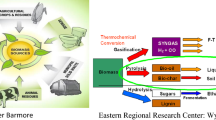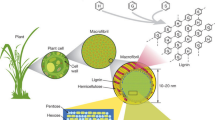Abstract
This paper focuses on the experimental study and comparative analysis of characteristics, boundary conditions and ignition behavior of slurry fuels prepared from peat, coal processing waste (slime and filter cake), and lignite. Waste turbine oil (with a fraction of 10%) was an additional combustible component. The use of waste oils in waste-derived blends can provide a significant increase in the integral characteristics of fuel ignition as well as increase its calorific value. We measured the ignition delay times, duration of burning, ignition temperatures, peak combustion temperatures, and emissions of sulfur and nitrogen oxides. These characteristics are fundamental for designing the production areas involving fuel supply, atomization, and combustion, as well as flue gas treatment. The experiments were conducted using a lab-scale furnace and small fuel portions. The relative efficiency ratios (considering energy, environmental, and cost criteria) of waste-derived blends were evaluated relative to conventional fuels, such as coal and fuel oil. We established that the most promising fuel slurries have a heterogeneous composition and consist of milled coal, slime, and peat. The averaged efficiency indicator of the studied mixtures varies in the range of 1.6–9.5 (versus coal) and 3.9–30.2 (versus fuel oil). In accordance with experimental data and calculations, the fuel consisting of 30% filter cake, 20% coal slime, and 50% water has the greatest potential in terms of a combination of energy, environmental, and cost criteria. The data obtained can be used to develop waste-to-energy technologies as well as to rationalize the involvement of low-rank fuels and wastes into the energy sector.
Graphic Abstract
















Similar content being viewed by others
References
Tsai, S.C.: Fundamentals of Coal Beneficiation and Utilization. Elsevier Scientific Pub. Co, Amsterdam (1982)
Cooper, B.R., Ellingson, W.A.: The Science and Technology of Coal and Coal Utilization. Springer Science & Business Media, Berlin (2013)
Lyu, S., Cao, T., Zhang, L., Liu, J., Li, G., Ren, X.: Assessment of low-rank coal and biomass co-pyrolysis system coupled with gasification. Int. J. Energy Res. 44, 2652–2664 (2020). https://doi.org/10.1002/er.5011
Li, D., Wu, D., Xu, F., Lai, J., Shao, L.: Literature overview of Chinese research in the field of better coal utilization. J. Clean. Prod. 185, 959–980 (2018)
Höök, M.: Coal coal and peat peat: Global Resources peal global resources peat global resources and future supply peal future supply peat future supply. In: Meyers, R.A. (ed.) Encyclopedia of Sustainability Science and Technology, pp. 2173–2194. Springer, New York (2012)
Li, Z.K., Wei, X.Y., Yan, H.L., Wang, Y.G., Kong, J., Zong, Z.M.: Advances in lignite extraction and conversion under mild conditions. Energy Fuels (2015). https://doi.org/10.1021/acs.energyfuels.5b01108
Yu, J., Tahmasebi, A., Han, Y., Yin, F., Li, X.: A review on water in low rank coals: the existence, interaction with coal structure and effects on coal utilization. Fuel Process. Technol. 106, 9–20 (2013)
Heikkinen, R., Laitinen, R.S., Patrikainen, T., Tiainen, M., Virtanen, M.: Slagging tendency of peat ash. Fuel Process. Technol. 56, 69–80 (1998). https://doi.org/10.1016/S0378-3820(97)00085-4
United States Geological Survey. Peat Statistics and Information. Mineral Commodity Summaries (2020). Prepared by Amanda S. Brioche. https://pubs.usgs.gov/periodicals/mcs2020/mcs2020-peat.pdf
World Energy Council: World Energy Resources: Peat., London, United Kingdom, 1–24 (2013). https://www.worldenergy.org/assets/images/imported/2013/10/WER_2013_6_Peat.pdf
Taylor, J.A.: Distribution and development of the world’s peat deposits. Nature 201, 454–456 (1964)
Vershinina, K.Y., Glushkov, D.O., Strizhak, P.A.: Characteristics of the ignition of the drops of organic coal–water fuels based on waste oils and industrial oils. Solid Fuel Chem. (2017). https://doi.org/10.3103/S0361521917030119
Kuan, Y.H., Wu, F.H., Chen, G.B., Lin, H.T., Lin, T.H.: Study of the combustion characteristics of sewage sludge pyrolysis oil, heavy fuel oil, and their blends. Energy 201, 117559 (2020). https://doi.org/10.1016/j.energy.2020.117559
Dmitrienko, M.A., Strizhak, P.A.: Coal-water slurries containing petrochemicals to solve problems of air pollution by coal thermal power stations and boiler plants: an introductory review. Sci. Total Environ. 613–614, 1117–1129 (2018). https://doi.org/10.1016/j.scitotenv.2017.09.189
Zhou, H., Li, Y., Li, N., Qiu, R., Cen, K.: Conversions of fuel-N to NO and N2O during devolatilization and char combustion stages of a single coal particle under oxy-fuel fluidized bed conditions. J. Energy Inst. 92, 351–363 (2019). https://doi.org/10.1016/j.joei.2018.01.001
Olympiou, G.G., Efstathiou, A.M.: Industrial NOx control via H2-SCR on a novel supported-Pt nanocatalyst. Chem. Eng. J. 170, 424–432 (2011). https://doi.org/10.1016/j.cej.2011.01.001
Tu, Y., Liu, H., Su, K., Chen, S., Liu, Z., Zheng, C., Li, W.: Numerical study of H2O addition effects on pulverized coal oxy-MILD combustion. Fuel Process. Technol. 138, 252–262 (2015). https://doi.org/10.1016/j.fuproc.2015.05.031
Mao, L., Li, H., Zhang, Y., Wu, C.: Preparing coal water slurry from BDO tar to achieve resource utilization: combustion process of BDO tar-coal water slurry. Energy Fuels 33, 10297–10306 (2019). https://doi.org/10.1021/acs.energyfuels.9b02479
Jianzhong, L., Ruikun, W., Jianfei, X., Junhu, Z., Kefa, C.: Pilot-scale investigation on slurrying, combustion, and slagging characteristics of coal slurry fuel prepared using industrial wasteliquid. Appl. Energy 115, 309–319 (2014). https://doi.org/10.1016/j.apenergy.2013.11.026
Staroń, A., Kowalski, Z., Staroń, P., Banach, M.: Analysis of the useable properties of coal-water fuel modified with chemical compounds. Fuel Process. Technol. 152, 183–191 (2016). https://doi.org/10.1016/J.FUPROC.2016.07.007
Chen, C.-Y., Chen, W.-H., Ilham, Z.: Effects of torrefaction and water washing on the properties and combustion reactivity of various wastes. Int. J. Energy Res. (2020). https://doi.org/10.1002/er.5458
Key World Energy Statistics (Statistics report). International Energy Agency, 1–80 (2020). https://www.iea.org/reports/key-world-energy-statistics-2020
ISO 11722:2013 Solid mineral fuels — Hard coal — Determination of moisture in the general analysis test sample by drying in nitrogen (2013). https://www.iso.org/ru/standard/62610.html
ISO 1171:2010 - Solid mineral fuels—determination of ash (2010). https://www.iso.org/ru/standard/55944.html
ISO 562:2010 - Hard coal and coke — determination of volatile matter (2010). https://www.iso.org/standard/55943.html
ISO 1928:2020 Coal and coke — Determination of gross calorific value (2020). https://www.iso.org/standard/75883.html
ASTM D240-19, Standard Test Method for Heat of Combustion of Liquid Hydrocarbon Fuels by Bomb Calorimeter, ASTM International, West Conshohocken, PA (2019). https://doi.org/10.1520/D0240-19. https://www.astm.org/Standards/D240
ISO 3733:1999 - Petroleum products and bituminous materials—determination of water—distillation method (1999). https://www.iso.org/standard/9219.html
ISO 6245:2001 - Petroleum products—determination of ash (2001). https://www.iso.org/standard/31156.html
ISO 2592:2017 Petroleum and related products — Determination of flash and fire points — Cleveland open cup method (2017). https://www.iso.org/ru/standard/67910.html
Qin, Y., Yang, D., Gu, F., Li, X., Xiong, W., Zhu, J.Y.: Biorefinery lignosulfonates as a dispersant for coal water slurry. Sustain. Chem. Process. 4, 1–8 (2016). https://doi.org/10.1186/s40508-016-0050-0
Zhang, K., Cao, Q., Jin, L., Li, P., Zhang, X.: A novel route to utilize waste engine oil by blending it with water and coal. J. Hazard. Mater. 332, 51–58 (2017). https://doi.org/10.1016/j.jhazmat.2017.02.052
Kijo-Kleczkowska, A.: Combustion of coal-water suspensions. Fuel 90, 865–877 (2011). https://doi.org/10.1016/j.fuel.2010.10.034
Vershinina, K.Y., Shlegel, N.E., Strizhak, P.A.: Recovery of waste-derived and low-grade components within fuel slurries. Energy (2019). https://doi.org/10.1016/j.energy.2019.07.031
Guo, F., Zhong, Z., Xue, H., Zhong, D.: Migration and distribution of heavy metals during co-combustion of sedum plumbizincicola and coal. Waste Biomass Valorization 9, 2203–2210 (2018). https://doi.org/10.1007/s12649-017-9955-4
Zhang, S., Feng, L., Peng, X., Mao, M., Chi, Y., Wang, F.: Effect of sludge pellets addition on combustion characteristics and ash behaviour of municipal solid waste. Waste and Biomass Valorization 11, 5351–5361 (2020). https://doi.org/10.1007/s12649-020-00996-5
Nyashina, G.S., Vershinina, K.Y., Strizhak, P.A.: Impact of micro-explosive atomization of fuel droplets on relative performance indicators of their combustion. Fuel Process. Technol. 201, 106334 (2020). https://doi.org/10.1016/j.fuproc.2019.106334
Nyashina, G.S., Vershinina, K.Y., Dmitrienko, M.A., Strizhak, P.A.: Environmental benefits and drawbacks of composite fuels based on industrial wastes and different ranks of coal. J. Hazard. Mater. 347, 359–370 (2018). https://doi.org/10.1016/j.jhazmat.2018.01.014
Kumar, A., Sah, B., Singh, A.R., Deng, Y., He, X., Kumar, P., Bansal, R.C.: A review of multi criteria decision making (MCDM) towards sustainable renewable energy development. Renew. Sustain. Energy Rev. 69, 596–609 (2017)
Yao, S.C., Manwani, P.: Burning of suspended coal-water slurry droplet with oil as combustion additive. Combust. Flame 66, 87–89 (1986). https://doi.org/10.1016/0010-2180(86)90036-2
Sakai, T., Saito, M.: Single-droplet combustion of coal slurry fuels. Combust. Flame 51, 141–154 (1983). https://doi.org/10.1016/0010-2180(83)90094-9
Malika, A., Mohammed, A., Guhel, Y.: Energetic combustion characteristics and environmental impact of Moroccan biomass wastes and their solid biofuel. Waste Biomass Valorization 10, 1311–1322 (2019). https://doi.org/10.1007/s12649-017-0128-2
Liu, J., Jiang, X., Zhou, L., Wang, H., Han, X.: Co-firing of oil sludge with coal-water slurry in an industrial internal circulating fluidized bed boiler. J. Hazard. Mater. 167, 817–823 (2009). https://doi.org/10.1016/j.jhazmat.2009.01.061
Guttikunda, S.K., Jawahar, P.: Atmospheric emissions and pollution from the coal-fired thermal power plants in India. Atmos. Environ. 92, 449–460 (2014). https://doi.org/10.1016/j.atmosenv.2014.04.057
Ramirez, M.I., Arevalo, A.P., Sotomayor, S., Bailon-Moscoso, N.: Contamination by oil crude extraction—refinement and their effects on human health. Environ. Pollut. 231, 415–425 (2017)
Tang, Q., Li, L., Zhang, S., Zheng, L., Miao, C.: Characterization of heavy metals in coal gangue-reclaimed soils from a coal mining area. J. Geochem. Explor. 186, 1–11 (2018). https://doi.org/10.1016/j.gexplo.2017.11.018
Zhao, C., Luo, K.: Sulfur, arsenic, fluorine and mercury emissions resulting from coal-washing byproducts: a critical component of China’s emission inventory. Atmos. Environ. 152, 270–278 (2017). https://doi.org/10.1016/j.atmosenv.2016.12.001
Li, Z., Ma, Z., van der Kuijp, T.J., Yuan, Z., Huang, L.: A review of soil heavy metal pollution from mines in China: pollution and health risk assessment. Sci. Total Environ. 468, 843–853 (2014)
Demirbas, A., Bamufleh, H.S., Edris, G., Alalayah, W.M.: Treatment of contaminated wastewater. Pet. Sci. Technol. 35(9), 883–889 (2017)
Acknowledgements
The study was supported by a grant from the Ministry of Science and Higher Education of Russia, Agreement No. 075-15-2020-806 (Contract No. 13.1902.21.0014).
Author information
Authors and Affiliations
Corresponding author
Ethics declarations
Conflict of interest
The authors have no conflicts of interest to declare.
Additional information
Publisher's Note
Springer Nature remains neutral with regard to jurisdictional claims in published maps and institutional affiliations.
Rights and permissions
About this article
Cite this article
Vershinina, K., Nyashina, G. & Strizhak, P. Lab-Scale Combustion of High-Moisture Fuels From Peat, Coal Waste and Milled Lignite. Waste Biomass Valor 12, 6619–6634 (2021). https://doi.org/10.1007/s12649-021-01482-2
Received:
Accepted:
Published:
Issue Date:
DOI: https://doi.org/10.1007/s12649-021-01482-2




